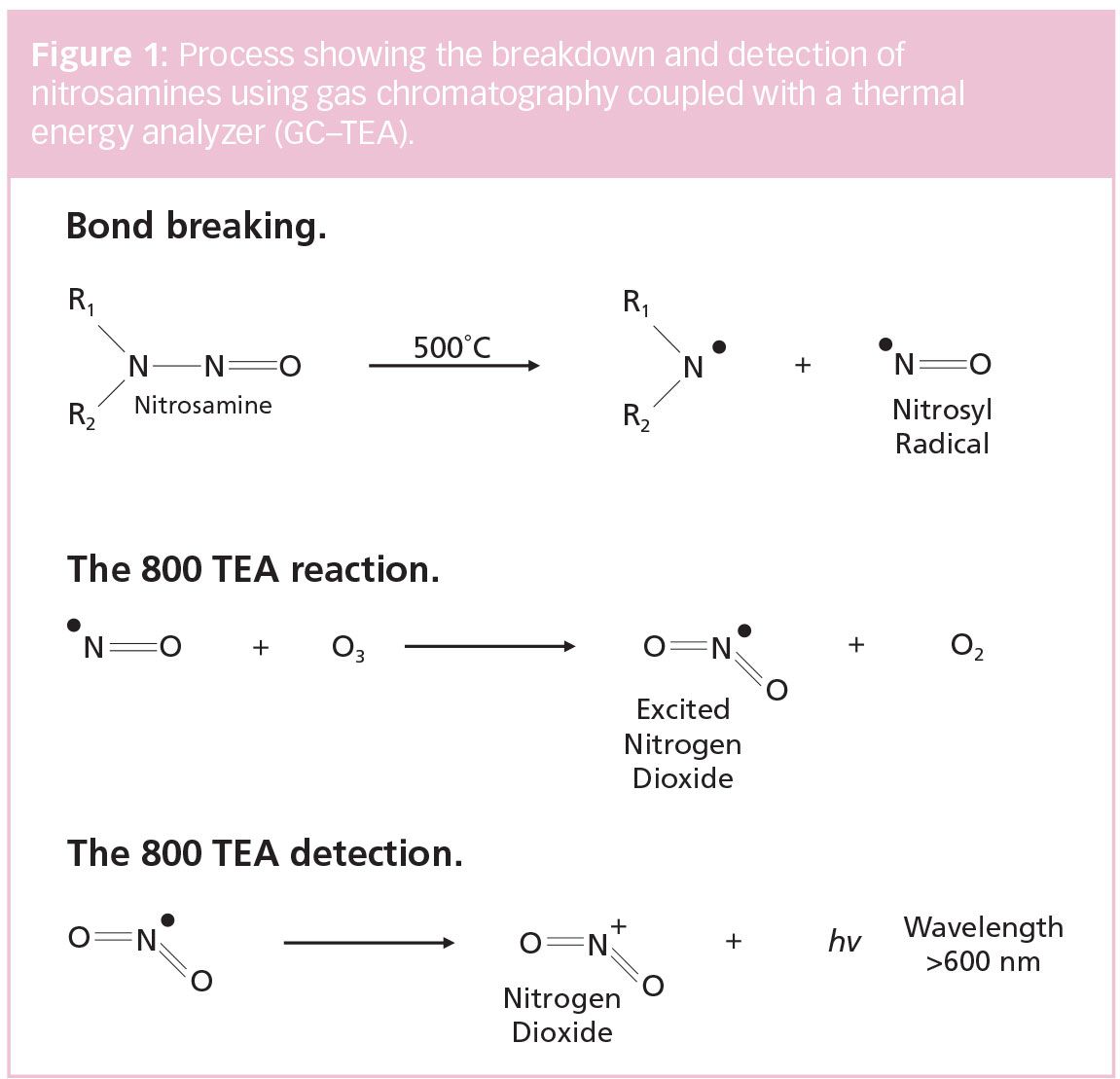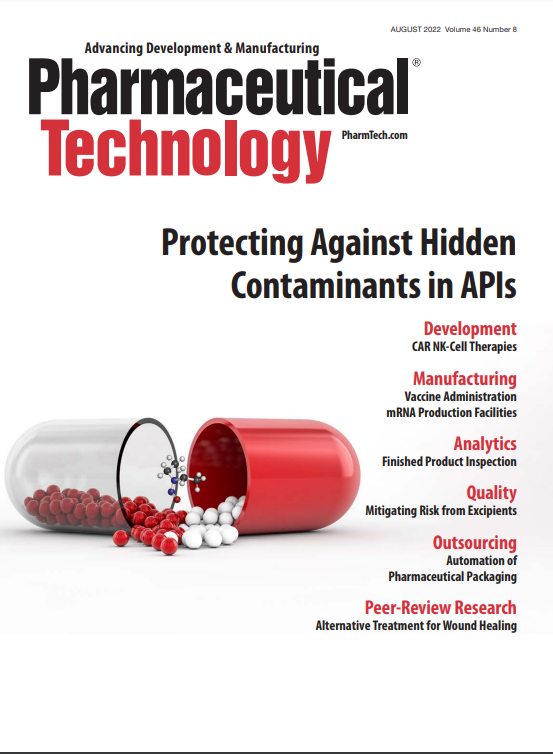Editor's Note
Editor’s Note: This article was published in Pharmaceutical Technology Europe’s August 2022 print issue.
Screening for apparent total nitrosamine content with a thermal energy analyzer offers a rapid way of identifying contaminated drug products.
ALEXSTUDIO - Stock.adobe.com

Nitrosamines have been found to increase the risk of certain types of cancer in humans (1), if exposed to them above acceptable levels over long periods of time. These organic compounds are formed by the interaction of secondary or tertiary amines with nitrite ions. Nitrosamines are easily produced under a variety of manufacturing conditions, and are frequently found in rubber products, smoked foods, brewing and malting, agrochemicals, packaging, cosmetics, and pharmaceuticals.
Editor’s Note: This article was published in Pharmaceutical Technology Europe’s August 2022 print issue.
There are many circumstances where nitrosamines can form, for example, sodium nitrite (NaNO2) is commonly used in the food industry as a preservative. When NaNO2 is in the presence of secondary or tertiary amines, it creates a potential source of nitrosamines. In research laboratories, amine solvents and dimethyl formamide, a common solvent containing dimethylamine, can degrade to secondary amines, which are known sources of nitrosamines.
In the pharmaceutical industry, nitrosamines were first detected in 2018 when N-Nitrosodimethylamine (NDMA) was found in the sartan family of drugs produced by the Zheijiang Huahai Pharmaceutical Company (2). Since then, several drug products, including angiotensin receptor blockers (ARBs), ranitidine, nizatidine, and metformin, have been found to contain unacceptable levels of nitrosamines (3). Most recently, Pfizer voluntarily recalled five batches of its blood pressure drug, Accupril, due to N-nitroso content (4). Now, finding the right nitrosamine detector solution has become a top priority for pharmaceutical manufacturers.
There is potential for nitrosamines to be present in APIs, depending on the API and the product manufacturing processes. If the product contains a small molecule API made by chemical synthesis, it is at risk of containing nitrosamines. One problem is that nitrosamines can form in the raw materials and API manufacturers might not know about the risk, therefore they might not know that they need to test.
However, the production environment further complicates this process. Nitrosamines can be produced when a secondary amine is present with a nitrating source, such as a nitrite or nitrosyl. A variety of conditions can cause the reaction, including acidity, the presence of reducing agents, or high temperatures. Any manufacturing process that brings a nitric oxide (NO) source in contact with an amine under the previously mentioned conditions has the potential to produce nitrosamines.
The possibility of nitrosamines being created is wider than just the presence of nitrites and amines during synthesis of the API. In pharmaceutical manufacturing, contamination is a big concern and can occur during API processing. Nitrites or amines may also be present in the raw materials themselves, or in the reagents or solvents.
In response to the discovery of contamination, the European Medicines Agency (EMA) introduced a requirement that all pharmaceuticals have an assessment of raw materials and manufacturing processes to reduce the risk of contamination or formation (5). The assessment includes analysis of where amines and nitrates are used in the manufacturing process; the possible contamination of raw materials with nitrosamines, amines, or nitrites; and the opportunities for contamination from other external sources. However, the problem can be complex. Amines produced as a by-product of one stage, if not properly removed, can be converted to nitrosamines in subsequent synthesis steps.
The presence of NDMA impurities in pharmaceutical products has caused regulatory agencies to take action and put pressure on the industry to improve the ways in which NDMA and other nitrosamines are detected.
As a result of increased concern and regulatory requirements, many laboratories are looking for instrumentation and techniques that can reliably identify and quantify nitrosamines. Current recognized methods for testing small molecule pharmaceutical products include gas chromatography–mass spectrometry (GC–MS) or liquid chromatography (LC)–MS. Although compounds can be detected, identified, and quantified via these methods, the equipment required to reach the limits of detection required is often costly, and interfering compounds can cause false positives. As a highly regulated industry, these analytical techniques also present challenges for ease of integration into the pharmaceutical manufacturing process.
An alternative detection technique that is gaining wide acceptance is to use highly specific chemiluminescent detection with a thermal energy analyzer (TEA) detection system. This can be easily coupled to a GC, and with the appropriate interface hardware, can also be coupled to an LC. TEA has been a standard method for nitrosamine analysis in many other industries since its design in the late 1960s, as it is able to rapidly identify and analyze N-nitroso compounds. The selectivity of the TEA for nitroso compounds means the matrix effect is not an issue as it can be with MS detection.
A typical analysis involves GC, used to separate components before the effluent is directed through a 500 °C pyrolyzer to initiate the series of reactions (Figure 1). At this temperature, the N-N bond is broken, and the nitric oxide (NO) radical is released. The gas is then passed into the TEA detector, where the NO reacts with ozone (produced in the unit from an oxygen source) to produce an electronically excited NO2 molecule, which subsequently relaxes to release a photon above 600 nm. The NO2 rapidly decays and emits near infrared light, which is detected by a sensitive photomultiplier, as shown in Figure 2. The system is kept under low pressure by a vacuum pump to reduce the likelihood of collisional relaxation. An ozone destroyer protects the pump and laboratory personnel from escaping excess ozone.
Figure 1: Process showing the breakdown and detection of nitrosamines using gas chromatography coupled with a thermal energy analyzer (GC–TEA). (Figure courtesy of the author)

The selectivity of the bond breakage can be controlled by the temperature of the pyrolyzer. At 500 °C, bond breakage is largely limited to the N-N bond, making this detector highly selective to nitrosamines. Increasing the temperature to 650 °C causes the breaking of carbon-nitrogen bonds, additionally allowing the detection of nitro groups.
Figure 2: Chemical reaction employed to strip down nitrosamine source. TEA stands for thermal energy analyzer. (Figure courtesy of the author)

The quantity of work that has been generated by the requirements of the regulatory bodies means that lengthy, fully speciated analysis using very expensive systems is not the most viable approach. A quicker and simpler screening method that can rapidly identify samples that contain nitrosamine content, which can then be passed on for further detailed analysis, offers a unique approach to clearing this bottleneck.
Rather than starting with a full specialized analysis, the apparent total nitrosamine content (ATNC) method using TEA detection determines the total nitrosamine content in a sample. ATNC gives a rapid and accurate result, showing both volatile and non-volatile components in a single readout. Any sample showing an ATNC below the specified level of concern cannot possibly contain any one compound above the total level, and so it can be deemed safe. If the ATNC value of a sample is positive, the sample can be passed to another system such as a GC–TEA so that volatile nitrosamines, such as NDMA, can be separated and quantified.
The TEA detector can be interfaced to a system for the measurement of ATNC (Figure 3). The system can be either a manually operated system that can fit easily into a fume hood or an automated version using a robotic autosampler. Sample prep for ATNC is minimal, and liquid samples can be injected directly. The solvent used in the sample is largely immaterial and can include samples in water, methanol, or dichloromethane. Viscous samples may need to be diluted for effective injection. Solid samples will need to be ground and extracted to transfer the nitrosamines into liquid form.
Figure 3: Total nitrosamine analysis. TEA stands for thermal energy analyzer. (Figure courtesy of the author)

In the manual system, rather than being subjected to pyrolysis, the samples are injected into refluxing ethyl acetate containing hydrobromic acid (HBr). A reaction with the HBr produces NO, a secondary amine, and bromine. A flow of nitrogen over the headspace of the reaction vessel then carries NO toward the TEA. A condenser coil prevents loss of the boiling solvent, and a second cold trap further cleans the vapour before it enters the TEA.
As previously mentioned, NO is then reacted with ozone to produce the signal. The typical injection size for the manual ATNC is 50 µL, although some users may choose to go as high as 500 µL. It should be noted that samples containing higher amounts of nitrosamines will more quickly deplete the HBr in the reaction vessel and necessitate replenishing more often.
The automated system works in a similar fashion, but each reaction is performed in its own individual vial. Up to 14 mL of sample have been tested in a 20 mL vial with 2 mL of HBr reaction mixture. Following the reaction, the headspace of the vial is then sampled. The higher sample volume and decreased headspace volumes of the automated system means a more concentrated headspace sample is passed to the detector, allowing for lower detection levels.
Because the configuration to the TEA detector is identical, many users utilize a switching valve to allow the same TEA unit to be used as either a GC detector or a total nitrosamine analyzer. Because the results are independent of the side groups of the nitrosamine, the results from this method are typically reported as N-N=O concentration in parts per million (ppm) or parts per billion (ppb). The mass/mass concentration of the compound containing the N-N=O will be different depending on its molecular weight.
Nitrosamine impurities are of increasing concern to consumers and regulatory agencies. These impurities can be easily formed in a number of conditions, and care must be taken to avoid their creation during manufacturing processes, or introduction from reagents, solvents, or packaging. As a result, tests and validations to detect potential contamination are likely to become standard approaches for regulatory bodies in the future. Therefore, there is a need for an analytical solution, such as the TEA with ATNC configuration, that allows for confident detection and quantification in APIs and finished drug products.
1. National Cancer Institute, Dictionary of Cancer Terms, NCI Dictionaries, cancer.gov [Accessed 22 June 2022].
2. FDA, “FDA Warns API Manufacturer Involved in Valsartan Recall, Provides Information for Patients Taking These Medications,” Press Release, fda.gov, 11 Dec. 2018.
3. FDA, Control of Nitrosamine Impurities in Human Drugs, Guidance for Industry, fda.gov (February 2021).
4. Pfizer, “Pfizer Voluntary Nationwide Recall of Lots of ACCUPRIL (Quinapril HCL) Due to N-Nitroso-Quinapril Content,” Press Release, 22 April 2022.
5. EMA, Nitrosamine Impurities in Human Medicinal Products, Assessment Report, ema.europa.eu, 25 June 2020.
Andrew James is marketing director, Ellutia Limited.
Pharmaceutical Technology Europe
Vol. 34, No. 8
August 2022
Pages: 29–31
When referring to this article, please cite it as A. James, “Detecting Apparent Total Nitrosamine Content in Pharmaceutical Drugs” Pharmaceutical Technology Europe 34 (7) 2022.
